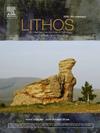Identifying ore-forming magma and tectonic setting of the Tongshan porphyry Cu deposit, NE China: Evidence from zircon trace elements and U–Pb–Hf isotopes
IF 2.9
2区 地球科学
Q2 GEOCHEMISTRY & GEOPHYSICS
引用次数: 0
Abstract
The Tongshan deposit is the largest porphyry Cu deposit in northeast China, which has the characteristics of complex metallogenic system formed by multiple overprinted mineralization events. Recently, the successful exploration of concealed orebodies and intrusions at Tongshan revealed various intrusive rocks in the mining area. However, the complex magmatic controls on the mineralization and the tectonic setting at Tongshan are still controversial. This paper reports the zircon geochemistry and U–Pb–Hf isotopic data from granodiorite porphyry, granodiorite, and dacite porphyry samples in the Tongshan deposit. Our new zircon U-Pb ages show that the newly discovered granodiorite porphyry dikes from drill hole ZK16–1 yield an age of 472.2 ± 1.1 Ma (n = 25, MSWD = 0.25). A comparative analysis of zircon geochemistry data from the granodiorite porphyry with previously studied fertile and barren intrusions at Tongshan reveals distinct geochemical signatures. Zircon crystallization temperatures for the granodiorite porphyry range from 663° to 742 °C, as calculated by the zircon Ti thermometer. The granodiorite porphyry samples exhibit relatively higher zircon ΔFMQ (0.70 ± 0.29) and Eu/Eu* values (0.52–0.73) compared to the barren intrusions at Tongshan, suggesting differences in magma oxidation states. Zircon Hf isotopic compositions show positive zircon ɛHf(t) values for the Ordovician granodiorite porphyry (+11.3 to +14.7, n = 15) and the Triassic suites (+3.4 to +13.2 for granodiorite and +6.7 to +12.5 for dacite porphyry, n = 30). The Ordovician granodiorite porphyry originated from mantle-derived magmas with high ɛHf(t) values, while the Triassic dacite porphyry and granodiorite resulted from the mixing of juvenile mantle materials with pre-existing crustal rocks, as evidenced by their broad ɛHf(t) values. Integration of zircon geochemistry and tectonic setting indicates that the Ordovician and Triassic ore-forming intrusions were formed in a subduction-related continental arc setting. Therefore, we proposed a genetic model for Tongshan, in which the Paleo-Asian Ocean and the Mongol-Okhotsk Ocean tectonic systems contributed to the two significant periods of intrusions and mineralization, respectively.

铜山斑岩型铜矿成矿岩浆及构造背景识别:锆石微量元素和U-Pb-Hf同位素证据
铜山铜矿床是东北地区最大的斑岩型铜矿床,具有多成矿事件叠加形成的复杂成矿系统特征。近年来,铜山隐伏矿体和侵入体的成功勘探,揭示了矿区内各种侵入岩。然而,复杂岩浆对铜山成矿作用的控制和构造背景仍存在争议。本文报道了铜山矿床花岗闪长斑岩、花岗闪长斑岩和英安岩斑岩样品的锆石地球化学和U-Pb-Hf同位素数据。ZK16-1钻孔新发现花岗闪长斑岩岩脉的锆石U-Pb年龄为472.2±1.1 Ma (n = 25, MSWD = 0.25)。铜山花岗闪长斑岩的锆石地球化学数据与前人研究过的肥沃和贫瘠侵入岩的对比分析显示出明显的地球化学特征。根据锆石Ti温度计计算,花岗闪长斑岩的锆石结晶温度在663 ~ 742℃之间。花岗闪长斑岩样品的锆石ΔFMQ(0.70±0.29)和Eu/Eu*值(0.52 ~ 0.73)均高于铜山裸岩,说明岩浆氧化状态存在差异。奥陶系花岗闪长斑岩(+11.3 ~ +14.7,n = 15)和三叠系花岗闪长斑岩(+3.4 ~ +13.2,英安岩斑岩+6.7 ~ +12.5,n = 30)的锆石Hf同位素组成均为正。奥陶系花岗闪长斑岩起源于高Hf(t)值的幔源岩浆,而三叠系英安岩斑岩和花岗闪长斑岩则是由幼年地幔物质与原有地壳岩石混合形成的,其较大的Hf(t)值证明了这一点。锆石地球化学和构造环境综合表明,奥陶系和三叠系成矿侵入体形成于与俯冲有关的大陆弧环境。因此,我们提出了古亚洲洋和蒙古-鄂霍次克洋构造体系分别对铜山的两个重要侵入期和成矿期做出了贡献的成因模式。
本文章由计算机程序翻译,如有差异,请以英文原文为准。
求助全文
约1分钟内获得全文
求助全文
来源期刊

Lithos
地学-地球化学与地球物理
CiteScore
6.80
自引率
11.40%
发文量
286
审稿时长
3.5 months
期刊介绍:
Lithos publishes original research papers on the petrology, geochemistry and petrogenesis of igneous and metamorphic rocks. Papers on mineralogy/mineral physics related to petrology and petrogenetic problems are also welcomed.
 求助内容:
求助内容: 应助结果提醒方式:
应助结果提醒方式:


